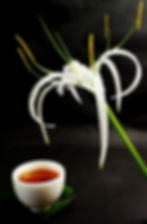Blog 48: Tea for Autumn
- Valley Brook Tea
- Aug 30, 2018
- 3 min read
Updated: Oct 18, 2018
In traditional Chinese herbal medicine theories, summer is when people get weaker due to the excessive body water loss. Based on the same theories, our organs have more burdens in the summer because people tend to consume more iced or chilled foods and drinks. Therefore, the beginning of autumn is a proper time for us to recover. In Chinese, this “course of recovery” is call Autumn Rehabilitation (Chinese: 养秋, pronunciation: Yang Qiu). A proper autumn rehabilitation is to prepare our physical bodies for the upcoming seasons. Tea, as a natural product, is perfect for this purpose. Today, let’s talk about what teas to drink in autumn.

For people who have sensitive body types, autumn can be as challenging as spring pollen season. The discomfort is often associated autumn dryness diseases. The very first sign of autumn dryness is a sore throat. The more severe symptoms are sinus allergies, dry skin, dry hair, getting cold and coughing, and nosebleeds. Chinese herbal medicine believes these symptoms are associated with excessive water loss in summer. Nonetheless, It can be remedied by intaking more water. Tea can provide extra nutritions (see our previous blogs here) more efficiently. However, not all teas are suitable for the autumn season. Here are some teas that we suggest for autumn.
There’s a say about tea and season: green tea for summer, oolong tea for autumn, and black tea for winter. Of course, we can always choose a tea based on our personal preferences. But this is a great guidance if we want to pair tea with seasons. In general, teas that are more moderate in nature are better for autumn. Unfermented teas, such as green tea and new white tea, are much cooler in nature; therefore, they are not suitable for autumn, which is a time that slowly turns cold.
Oolong tea, as suggested, is ideal for autumn. Being a half-fermented tea, oolong tea is moderate. Autumn is also the time that most new oolong products from the spring harvest come into the market. Oolong tea, especially Wuyi oolong made with traditional techniques, are effective in reducing blood fat and cholesterol. It’s helpful in relieving autumn dryness symptoms and losing weight. Qi Lan, Iron Luo-Han, Gold Peony and Shui Xian are all excellent during this time of the year.

Aged white tea is also ideal for autumn. In fact, aged white tea is nearly appropriate for all seasons. White tea has a simple tea-making processes. Unlike most other teas that have hot fixation and fermentation, white tea tea-making only has withering and drying. White tea preserves more active enzyme and polyphenols. However, since white tea can be aged, there is quite a difference between new white tea and aged white tea. New white tea is not as oxidized as aged white tea, so it’s more similar to green tea, which is cooler in nature. For autumn, aged, mild white tea are much better. Typically, if a white tea is aged for 3 years or more, it’s considered as an aged tea.

Finally, we’d like to state that this blog is only a suggestion based on traditional Chinese herbal medicine theories. You don’t have to follow the principles introduced in this blog. After all, tea-drinking is a cultured pleasure. It should never have the dominance over our choices.
I hope you enjoyed today’s blog. As always, if you have questions or suggestions, please leave a comment, tweet us @valleybrooktea or email the author directly at zhang@valleybrooktea.com. Please also follow us on Instagram @valleybrooktea and join our mail list to get our daily tea updates and our latest promotions!
